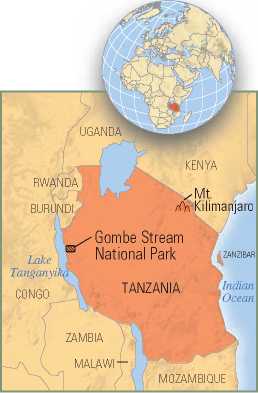What Determines the Behavior of Nonhuman Primates?
Diet, type of social organization, reproductive patterning, differences between the sexes, and the particular ecosystem a group of primates inhabits all contribute to the behavior of
Nonhuman primates. For many years primate behavior was seen as environmentally determined and tied to a certain diet and characteristics of the ecosystem. Today primatologists have established a strong socially learned component to primate behavior. Compared to other mammals, primates are characterized by a relatively long growth and development period that allows young primates to learn the behaviors of their social group. Some of these behaviors are influenced by the biology of the species while other behaviors derive from the traditions of the group.
Why Do Anthropologists Study the Social Behavior of Primates?
The study of the social behavior of primates has contributed significantly to ecology and evolutionary theory. In addition, analysis of the behavior of monkeys and apes living today— especially those most closely related to us—provides important clues from which to reconstruct the adaptations and behavior patterns involved in the emergence of our earliest ancestors. The more we know about our nearest living relatives, the more it becomes clear that many of the differences between apes and humans reflect differences in degree of expression of shared characteristics.
Do Nonhuman Primates Possess Culture?
The more we learn of the behavior of our nearest primate cousins, the more we become aware of the importance of learned, socially shared practices and knowledge among the homonoids. This raises the question of whether chimpanzees, bonobos, and the other apes have culture. The answer appears to be yes. Detailed study of ape behavior has revealed variation among groups in use of tools and patterns of social engagement; these differences seem to derive from the traditions of the group rather than a biologically determined script. Humans share with the other apes an ability to learn the complex but flexible patterns of behavior particular to a social group during a long period of childhood dependency.

In October 1960, the young Jane Goodall sent word back to her mentor, paleoanthropologist Louis Leakey, that she had observed two chimps turning sticks into tools for fishing termites out of nesting mounds (or termitarias). Leakey replied, “Now we must redefine tool, redefine Man, or accept chimpanzees as humans"37 Field studies of primates by Western scientists have always contained a degree of anthropocentrism and a focus on what nonhuman primates can tell us about ourselves. How and why did humans develop as we did during the course of our evolutionary history? Because culture, tool use, and language were thought to be uniquely human, perhaps studies of primate behavior might unravel an old nature-nurture question: How much of human behavior is biologically determined and how much of it derives from culture?
Research into primate behavior has shown again and again the behavioral sophistication of our closest living relatives—the anthropoid primates in general and the homi-noids in particular. Certainly, biology plays a role in primate behavior, but there are times that behavior is determined by the social traditions of the groups. Of course, as with humans, nature and nurture are linked. Primates require more time to reach adulthood compared to many other mammals. During their lengthy growth and development, young primates learn the behaviors of their social group.
While Goodall was originally criticized for giving names to the chimps she studied (David Greybeard and Goliath were the two chimps she first observed stripping twigs of their leaves to fish for termites), field studies have documented that primates know one another as individuals and can vary their behavior accordingly. The same is true of many other long-lived social mammals, such as elephants and dolphins. Observations of primates in their natural habitats over the past decades have shown that social interaction, organization, learning, reproduction, care of the young, and communication among our primate relatives are similar to human behavior.




 World History
World History









